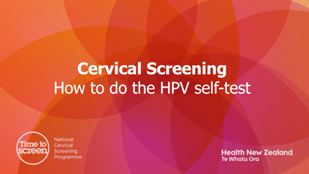Cervical screening: how to do the HPV self-test audio HE1200

A downloadable file providing an overview of the Cervical Screening Programme and the range of options available to do a cervical screening test. Designed to support people to decide which options are best for them (in consultation with their healthcare provider). This resource applies to cervical screening from 12 September 2023.
Audio is a MP3 file that can be downloaded to play on a range of devices including computers and MP3 players.
Activate the download button to download this file to your device.
TellMe is another way to access audio, especially for someone who may not be online or who has limited access to the internet. You access TellMe via your landline or mobile phone.
Phone 0800 835 563 to obtain your local number. Or you can access TellMe via Amazon Echo Smart Speaker devices. To get started, you need to enable the TellMe skill by asking Alexa to enable My Information and then follow the prompts.
The full resource:
Cervical Screening: How to do the HPV self-test
This guide will help you collect your own vaginal sample. If you are unsure about anything or have any difficulty with the test, ask your healthcare provider for help.
If you choose to do a self-test you will be given a test kit with detailed instructions on what to do. If you have any questions or difficulty with the test, ask your healthcare provider for help.
Make sure your details are correct on the label and form and add anything that may be missing. You may need to fill in some information, like the date you do the test.
What if I make a mistake?
It is very easy to take your own sample, and this is just as accurate as one taken by a healthcare provider. It’s very unlikely you’ll get anything wrong.
It’s okay to continue with the test if you:
- have touched the swab tip with your fingers (though it is best to avoid this);
- have inserted the swab into your vagina but are unsure if you have inserted it far enough.
If you drop your swab, let your healthcare provider know and ask them for a replacement.
Taking your sample
There may be some variation between the type of self-test swab included in this guide with the swab used by your healthcare provider.
Before you begin, ask your provider about the kit you will be using. Confirm with them the instructions for what to do with your swab once you have collected your sample, as this will depend on which kit is being used.
Step 1.
Wash your hands with soap and water and dry them thoroughly.
Step 2.
In a private space, find a comfortable position to take your sample. You may like to sit, stand, lie down or squat. If you cannot find a position that works for you, ask your healthcare provider for help.
Step 3.
Take the tube containing the swab out of the bag and remove the swab stick. You may need to hold and twist the cap to break the paper seal.
Try not to touch the swab tip either with your fingers or against any surface.
Step 4.
Holding the swab stick halfway down, use your free hand to open your vagina and gently insert the tip of the swab about 4-5cm (about the length of your thumb, similar to inserting a tampon).
Most people find it easy and comfortable to do. If you experience any pain, then draw the swab back a bit until it is more comfortable or ask your healthcare provider to assist.
Step 5.
Rotate the swab about 4 times (around 20 seconds), gently touching the sides of the vagina, then remove.
Step 6.
Once you have collected your sample, follow the kit instructions for next steps on what to do with the swab. Ask your healthcare provider for more information or assistance with this if needed.
Make sure the cap on your sample is put on tightly, so it is well sealed.
Step 7.
Dispose of any leftover materials in the rubbish bin, then wash your hands with soap and water and dry them thoroughly.
Step 8.
Place the completed sample and form back into the bag, seal it and give it back to your healthcare provider.
For more information about the National Cervical Screening Programme, HPV and cervical cancer, your options, and where to book an appointment, visit www.TimeToCervicalScreen.nz or freephone 0800 729 729 from 8am – 8pm Monday to Friday, and 9am – 1pm Saturday, or email screening@health.govt.nz